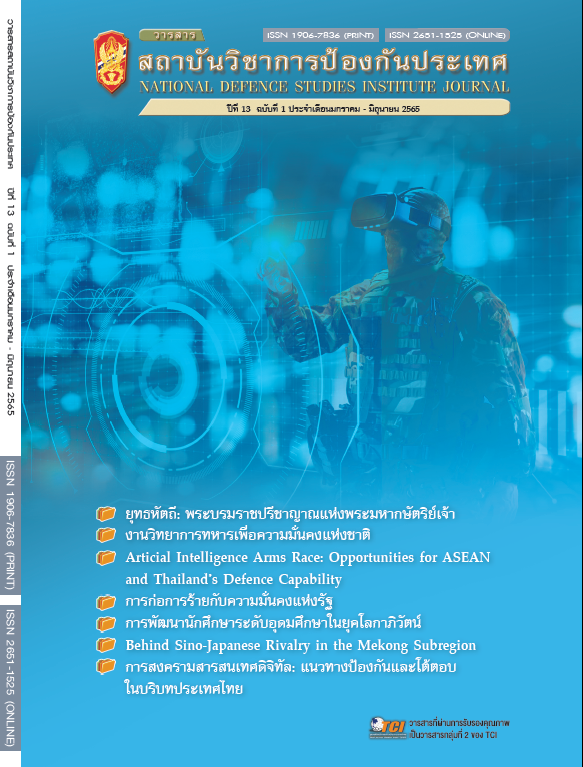Digital Information Warfare: an Approach of Protection and Response in Thailand Contexts
Main Article Content
Abstract
The objectives of this thesis are to 1) study the behaviour of digital information technology and perceptions of security officials on digital information warfare, 2) study the attitudes of security officials to the digital information warfare, readiness for the information warfare in the current state, and guidelines on responding preparation for coping 3) propose guidelines on preventing information warfare, and countermeasures, and 4) develop influential models (equations) of information warfare attitudes and preparation toward the prevention and countermeasures. The study is a quantitative research. The leading theory of the research design is the Warden's Five Ring System. Data Collection Tools from the research population consisted of 867 military officers, 1,267 police officers and 878 district bailiffs, totaling 3,012 people. The sample group used in the research was 341 security officers. All respondents completed and returned the questionnaires (100%). The statistics used in the data analysis are 1) descriptive statistics (percentage, mean, and standard deviation) and 2) multiple linear regression analysis. The hypothesis testing resulted in the highly influential factors to preventing information warfare: the importance of developing information technology infrastructure (R2=0.754) and analysis of the information threat situation of security personnel (R2=0.863). The high influencing factors to the appropriate interaction approach are disinformation about the primary institution (R2=0.726) and establishing a central agency for information security (R2=0.790). The hypothesis test also generated 12 equations (models) of information warfare attitudes and preparation influence toward the prevention and countermeasures.
Article Details

This work is licensed under a Creative Commons Attribution-NonCommercial-NoDerivatives 4.0 International License.
The articles, images, tables, graphs, written content, and opinions published in this journal are solely those of the authors and do not necessarily reflect the views or positions of the National Defence Studies Institute or its academic affiliates.
References
นพปฎล สุดเฉลียว. (2562). ความพร้อมของราชการส่วนภูมิภาคในการจัดการความมั่นคงภายใต้ภัย คุกคามรูปแบบ ใหม่:กรณีศึกษาจังหวัดจันทบุรี. มหาวิทยาลัยราชภัฏรำไพพรรณี. จันทบุรี.
สุรชาติ บำรุงสุข. (2553). ปฏิบัติการข่าวสาร. สถาบันข่าวกรอง สำนักข่าวกรองแห่งชาติ. (จุลสาร).
สำนักนายกรัฐมนตรี. สำนักงานสภาความมั่นคงแห่งชาติ. (2560). ยุทธศาสตร์การรักษาความมั่นคงปลอดภัยไซเบอร์แห่งชาติ พ.ศ.2560-2564. สืบค้นจาก nsc.go.th/wp-content/uploads/2018/08/strategyit60-64-1.pdf
Alberts, D. S., Garstka, J. J., Hayes, R. E., & Signori, D. A. (2001). Understanding information age warfare.Retrieved from https://apps.dtic.mil/sti/citations/ADA395859
Anand, V. (2006). Chinese Concepts and Capabilities of Information Warfare. Strategic Analysis, 30(4),781-797. Retrieved from https://www.idsa.in/strategicanalysis/ChineseConceptsandCapabilitiesofInformationWarfare_vanand_1006
Cockrell, M. C. D. (2017). Russian Actions and Methods against the United States and NATO.Military Review, (September 2017 Online Exclusive Article). Retrieved from https://www.armyupress.army.mil/Journals/Military-Review/Online-Exclusive/2017-Online-Exclusive-Articles/Russian-Actions-and-Methods/
Krejcie, R. V. and Morgan, D.W. (1970). Determining Sample Size for Research Activities. Educational and Psychological Measurement, 30(3), 607-610.
Panarin, I. (2008) The Information Warfare System: The Mechanism for Foreign Propaganda Requires Renewal. Voyenno-Promyshlennyy Kuryer, (October 2008).
Pratkanis, A. R. (1997). The Social Psychology of Mass Communications: An American Perspective. In Halpern, D. F. and Voiskounsky, A. (Ed), States of Mind: American and Post-Soviet Perspectives on Contemporary Issues in Psychology (p.126-159). New York: Oxford University.
Schwartau, W. (1994). Information warfare--Chaos on the electronic superhighway. New York: Thunder's Mouth Press.
Szafranski, R. (1995). A Theory of Information Warfare: Preparing for 2020. Retrieved from https://nsarchive.gwu.edu/document/17602-col-richard-szafranski-theory-information
Thomas, T. L. (2000). Kosovo and the current myth of information superiority. The US Army War College Quarterly: Parameters, 30(1), 13-29.
US Joint Chiefs of Staff, Joint Publication 3-13. (1998). Information Operations.
Ventre, D. (2016). Information warfare (2Ed rev. and updated). London: ISTE Ltd.
Warden, J. (1995), The Enemy as system. Air Power Journal, (Spring), 30-56.
Wik, M. W. (2002). Revolution in information affairs: Tactical and strategic implications of information warfare and information operations. Retrieved from http://dodccrp.org/events/5th_ICCRTS/papers/Track8/071.pdf
Wilson, T. D. (1981). Models in information behaviour research. The Journal of Documentation, 3(55),249-270.


